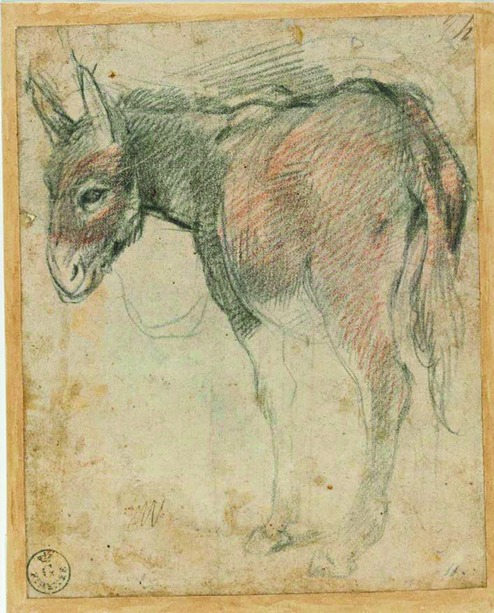
When I heard of a politician's description of another as a 'gadha', a set of thoughts brayed into my skull.
The first was simple, lexical: what is the etymology of 'gadha'? A quick look at the Oxford Hindi-English Dictionary (R.S. McGregor, 1993) showed it was derived from the Sanskrit gardabha which cue, in turn, led me to Vaman Shivram Apte's Sanskrit-English Dictionary (Motilal Banarsidass, 1970). That gold mine of a book confirmed the etymology for gadha — gardabha, in Sanskrit. But what about 'khur'? That, too, is the Sanskrit for donkey, ass. But khur sounds so Arabic, so Persian. And khurgosh, the 'donkey-eared', is surely a Perso-Arabic word for the all too common Indian hare. I was glad to find Mohammad Mustafa Khan 'Maddah's Urdu-Hindi Dictionary (1959) confirm that 'khur' is of Arabic and Persian origin. So, in the name of this animal of the poorest of poor circumstances, three languages - Sanskrit, Arabic and Persian - have come together in a uniform civil ode to common origins, distinct personalities.
The second was also simple, but speculative: why is donkey or ass a term of abuse? What has that benign creature with large bulbous eyes that seem to be on the verge of tears, making one want to say to it, self-beguilingly, in S.D. Burman's voice, " Kahe ko roye? Saphal hogi teri aradhana, kahe ko roye?", done to become a swear-word? 'Gadha' does not, of course, pack the venom of other herpetology-derived swear-words like cobra, viper, scorpion. It does not seethe with the contempt of mammalogically-derived words like rat or swine. It does not fling the outright insult of 'son of a b***h', linked, incidentally, to Shakespeare's "...son and heir of a mongrel bitch" (King Lear, Act 2, Scene ii). Compared to those, gadha, ass or donkey is almost an endearing abuse. But it is, nonetheless, an abuse. And with the 'd' stressed to 'dd' to become gaddha, it becomes even more of an abuse, revealing the phonetic dimensions of swearing.
The Apte dictionary did more than give the word's etymology. It cited an early use of gardabha by Chanakya in the Chanakya-Sataka which notes three qualities of that most ill-treated beast of burden:
"Avishrantam vahedbharam shitoshnam cha na vindati
"Sasantoshastatha nityam trini shikshet gardabhat"
The Calcutta-based Sanskritist, Vivek Mundra, has translated this nugget for me as, "Without resting it bears its burden, unaffected by heat or cold, it is always content."
This led me, in plain nostalgia, to Munshi Premchand's altogether brilliant short story, "Do baelon ki katha (The story of two bullocks)", which gives the same Chanakya picture of the gardabha in a modern idiom. I have known the story for years, relishing every line in it, for its unbelievably nuanced understanding of animal behaviour. Munshi ji opens the story with a reflection on the donkey which (poorly translated) reads: "Among animals, the ass is taken to be the dumbest. When we want to dub someone 'the ultimate in dumbness' we call him an ass. Whether the ass is really dumb, or whether its innocence and its credulous forbearance have given it this epithet, cannot be said for sure. Cows can gore, suckling cows can, for sure, take on the colours of a lioness. And that poor wretch, the dog, can also on occasion turn angry. But no one has ever heard of an angry ass. Beat the poor fellow as much as you want to, throw before it as spoilt and stale a bundle of grass as you wish to, the ass will not let as much as a trace of discontent cross its face. Nor does it betray joy. During the season of Vaishakh it may gambol a bit but never ever can we catch happiness, real happiness, lighting up the ass's face. Melancholy is what its face reflects, in a permanent, unchanging expression. Pleasure and pain, loss and gain, make no difference to that static, un-changing mood of the ass. The equanimity of rishis and munis may be said to have reached its very summit in that animal. And yet Man calls it dumb. Nowhere else is true nobility as ill-treated as in the dumbing-down of that saintly creature. Goodness, unaffected and inherent, is perhaps unsuited for this world of ours."
Vivek Mundra, as I said, helped me with the ass's Sanskritic credentials. Another Vivek, Vivek Menon, the wildlife conservator, has done the same with its scientific credentials. He tells us in his Indian Mammals — A Field Guide (Hachette, 2014) that the domestic donkey or ass (Equus asinus asinus) apart, India has three kinds of wild asses (E. hemionus, E. africanus and E. kiang). The first, as Chanakya and Premchand tell us, is something of a saint. The other three, as Menon tells us, are nothing of the kind. They can gallop, protect their turf with zeal, their stallions tussling with rivals to make love in their 'harems' with passion. The khur (E. hemionus) in Kutch, Gujarat and the kiang (E. kiang) in Ladakh and Jammu and Kashmir are no gadhas in the sense we use that term.
The emperor Asoka must have had them, among others of their kind in mind when, in his Pillar Edict V proclaiming certain categories of animals as protected, he included savey chatupadey (all quadrupeds) that were not to be eaten. Akbar and Jehangir hunted them. Outright 'dumb' creatures do not draw royal projectiles.
And yet, 'ass', 'donkey', 'mule' have been used interchangeably, un-thinkingly, abusively down the ages - to make political, personal sallies.
Benjamin Disraeli is believed to have sneered at Gladstone's cabinet saying, famously, that it was "half full of asses". This was in the British Parliament. When the Speaker pulled him up and asked for a retraction, Disraeli said, "All right, half the cabinet is not full of asses." The story may be apocryphal but has provoked laughter over the decades.
I remember V.K. Krishna Menon describing, in 1963, a political initiative being "like the proverbial mule - with neither pride of ancestry nor hope of progeny". The mule is believed to be barren. I am not sure if this is scientific but the swear-word is strengthened.
There is a whole hierarchy of abuse. All of it revoltingly creative. The 'higher-up' galis may be called galis of the fecund human imagination, the next-below of the fervid imagination, with the lowest order of galis being those of the fetid imagination. There the gadha abuse is not limited to the ass as ass but explores the ass's limbs from its ears down to its genitalia and, in a hop from Equidae to Siphonaptera, to the flea that lives in those parts. And such is the microscopic intensity of the fetid imagination, now rampant on social media, that it does not leave even that ectoparasite of mammals to itself but goes into its biting, fighting and mating behaviour. And why? To paste that on to a human target.
If the holy cow, the wise elephant, the cunning fox, the stupid ass, the sly crow, knew how to swear, they would invent for man the vilest, most degraded, most unrepeatable adjectives as would leave his swearing imagination chewing at mud for cud.










